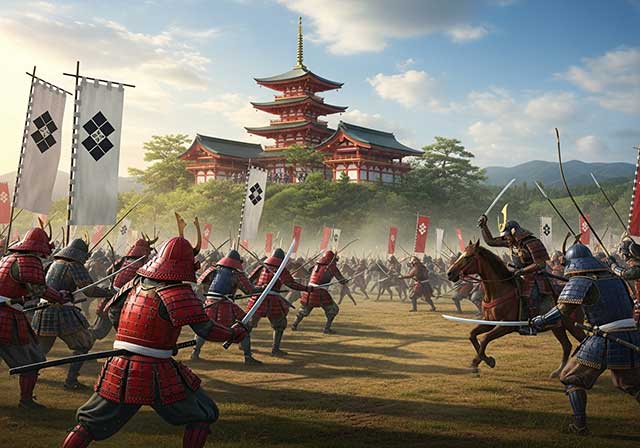
In response to the Oda clan's advance into the western part of Mikawa Province, in August 1542, the combined forces of Imagawa Yoshimoto and Matsudaira Hirotada (father of the future shogun Tokugawa Ieyasu) advanced into the Ikutahara area.
After receiving reports from his scouts, Oda Nobuhide (father of the future first unifier of Japan, Oda Nobunaga) left Anjo Castle, crossed the Yahagi River, and took up a position in the Kamibada area.
From Kamibada in October, Nobuhide advanced to Azukizaka, an area located southeast of the Matsudaira clan's stronghold, Okazaki Castle. It was here that the battle took place, which later became known as the First Battle of Azukizaka.
The allied forces of Imagawa and Matsudaira were commanded by the monk Taigen Sessai from Suruga Province, who was the chief advisor to Imagawa Yoshimoto.
Nobuhide was supported by his brothers: Nobuyasu, Nobumitsu, and Nobuzane.
The battle was short but fierce. Oda Nobuhide managed to defeat the allied forces, thereby maintaining his influence in the province of Mikawa.
The seven samurai who distinguished themselves in battle were awarded the honorary title of “Seven Spears of Azukizaka.” They were:
- Oda Nobumitsu,
- Oda Nobufusa,
- Okata Shigeyoshi,
- Sassa Masatsugu,
- Sassa Magosuke,
- Shimokata Sadakiyo,
- Nakano Itiyasu.
The victory gave Nobuhide the opportunity to temporarily weaken the position of his unfriendly neighbor, the Matsudaira clan, and switch his attention to other tasks and problems.
However, some historians believe that the first battle of Azukizaka may never have actually taken place. It is believed that the information about it was falsified by the chroniclers of the Oda clan.
See also
-
The Siege of Hara Castle

The Shimabara Rebellion of 1637–1638, which culminated in the siege of Hara Castle, was the last major uprising of the Edo period and had serious political consequences.
-
Battle of Tennoji

The confrontation between Tokugawa Ieyasu and Toyotomi Hideyori during the “Osaka Winter Campaign” ended with the signing of a peace treaty. On January 22, 1615, the day after the treaty was signed, Ieyasu pretended to disband his army. In reality, this meant that the Shimazu forces withdrew to the nearest port. On the same day, almost the entire Tokugawa army began filling in the outer moat.
-
Siege of Shuri Castle

The Ryukyu Kingdom was established in 1429 on Okinawa, the largest island of the Ryukyu (Nansei) archipelago, as a result of the military unification of three rival kingdoms. In the following years, the state's control spread to all the islands of the archipelago.
-
The Siege of Fushimi Castle

Fushimi can perhaps be considered one of the most “unfortunate” castles of the Sengoku Jidai period. The original castle was built by Toyotomi Hideyoshi in the southeast of Kyoto in 1594 as his residence in the imperial city.
-
The Siege of Otsu Castle

The siege of Otsu Castle was part of the Sekigahara campaign, during which the so-called Eastern Coalition, led by Tokugawa Ieyasu, fought against the Western Coalition, led by Ishida Mitsunari. Otsu Castle was built in 1586 by order of Toyotomi Hideyoshi near the capital Kyoto, on the site of the dismantled Sakamoto Castle. It belonged to the type of “water castles” — mizujō — as one side of it faced Japan's largest lake, Lake Biwa, and it was surrounded by a system of moats filled with lake water, which made the fortress resemble an island.
-
The Siege of Shiroishi Castle

The siege of Shiroishi Castle was part of the Sekigahara campaign and took place several months before the decisive battle of Sekigahara. The daimyo of Aizu Province, Uesugi Kagekatsu, posed a serious threat to Tokugawa Ieyasu's plans to defeat the Western Coalition, and Ieyasu decided to curb his actions with the help of his northern vassals. To this end, he ordered Date Masamune to invade the province of Aizu and capture Shiroishi Castle.
-
The Second Siege of Jinju Castle

During the two Korean campaigns of the 16th century, the Japanese repeatedly had to capture enemy fortresses and defend occupied or constructed fortifications from the combined Korean and Chinese forces. Among all the operations of that time, the second siege of Jinju Castle is considered the most interesting from the point of view of siege warfare.
-
The Siege of Takamatsu Castle

The siege of Takamatsu Castle in Bitchu Province is considered the first mizuzeme, or “water siege,” in Japanese history. Until then, such an original tactic had never been used.

